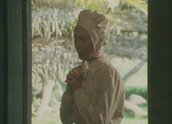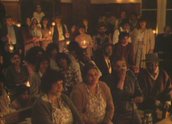


Women of the Sun (1982)
Synopsis
This four-part television drama series follows the lives of four generations of Aboriginal women.
Episode one, Alinta: The Flame, depicts an Aboriginal family clan in 1824 living peacefully by the ocean, hunting, fishing and gathering foods. Alinta (Naykakan Munung) is on the verge of womanhood when white settlers move onto the Aboriginal peoples’ land and take over their resources, leading to a bloody conflict.
Episode two, Maydina: The Shadow, introduces the aftermath of the massacres, with remnant populations of Aboriginal peoples struggling to survive. In 1895, Maydina (Mawuyul Yanthalawuy) and her daughter Biri (Sonia Pozzana), end up on a property owned by a zealous Christian woman, Mrs McPhee (Julia Blake). Maydina is determined to pass on her cultural knowledge to her daughter but the Board for the Protection of Aborigines removes Biri from Maydina’s custody.
Episode three, Nerida Anderson, stars Justine Saunders as Nerida, an articulate, well-educated young woman determined to see improvements in the living conditions of her people on the Koomalah Aboriginal Reserve. This episode specifically addresses Aboriginal poverty in the 1930s.
Episode four, Lo-Arna, is set in 1982. The world of Lo-Arna (Michelle Lanyon) is turned upside down when she discovers her mother is Aboriginal and not Polynesian, as she’d been told by her adoptive parents.
Curator’s notes
This landmark television series presented a new way of seeing and understanding colonial Australia: through the eyes of Aboriginal women. It dramatised the lived experience of many Aboriginal women, exposing a history of racism in Australia and its impact on the lives of Aboriginal women and their children from colonial through to contemporary times.
Each episode portrays issues faced by many Aboriginal women in south-eastern Australia, as well as in other parts of the country: the massacre of family members; sexual exploitation; the removal of children by the government; poverty and poor housing; medical and employment discrimination; and ultimately the loss of cultural identity, knowledge and connection to country.
The directors of Women of the Sun, as both male and non-Aboriginal, took a persuasive stance against the Australian myth of a ‘peaceful settlement’ and addressed the historical background to many contemporary social, economic and political issues.
The series shone a new light on Australian history and presented stories never seen before on prime-time television. It provided positive imagery of Aboriginal people, cultural heritage and traditions and changed the way Australians saw themselves and their place in this country.
For further insights into the series see the documentary Women of the Sun … 25 Years Later (2006), produced and directed by Bob Weis, the producer of the original series.
Women of the Sun was first broadcast on SBS (then Channel 0/28) in Melbourne and Sydney on successive Monday evenings: 5, 12, 19 and 26 July 1982. It won the 1982 United Nations Association of Australia media peace prize, and two AWGIE (Australian Writers’ Guild) awards: Outstanding Script of the Year and Best Original Writing for Television.
- Overview
- Curator’s notes
- Video 3 clips
- Principal credits
- Find a copy
- Make a comment
- Map
- Add your review



